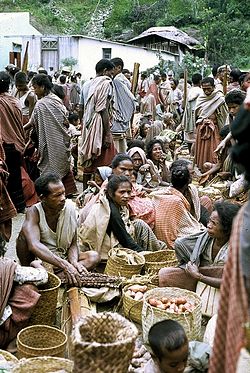
Back شعب كيماك ARZ Kemak German Suku Kemak ID Кемактар Kazakh Kemak (lud) Polish Кемаки Russian ภาษาเกมัก Thai
 Kemak people at the market in Atsabe, East Timor, circa 1968–1970. | |
| Total population | |
|---|---|
| 71,000[1] | |
| Regions with significant populations | |
| Timor: | |
| 61,969 (2010)[2] | |
| 10,800[3] | |
| Languages | |
| Kemak, Indonesian, Kupang Malay, Tetum, Portuguese | |
| Religion | |
| Christianity (94% in Timor-Leste, 90% in Indonesia), Folk religion (6% in Timor-Leste, 10% in Indonesia) | |
| Related ethnic groups | |
| Mambai people (Timor), Tokodede people, Tetum people, Austronesians, Melanesians | |
The Kemak (Portuguese: Quémaque, also known as Ema) people are an ethnic group numbering 80,000 in north-central Timor island. They primarily live in the district of Bobonaro, East Timor, while the rest live in the East Nusa Tenggara province of Indonesia.
They are close to the Tetum people.[clarification needed] The Kemak people speak the Kemak language. They are one of the smallest of the 14 Austronesian subgroups in Timor.[4] Most of them are adherents of traditional beliefs, while part of them profess the Catholic faith. Territorial community is headed by a leader, divided into genera. There are three levels of conjunctions. The "private" type of group corresponds to the level of uma or house. It does not only mean housing, but its category includes the exogamous groups of older and younger brothers who share a common ancestor. The "collective" type refers to the Morobe community, which encompasses 7 villages containing mainly 3 houses, and united by a common ritual cycle.[5]
- ^ "Kemak". Ethnologue. Retrieved 2018-03-24.
- ^ Catharina Williams-van Klinken & Rob Williams (2015). "Mapping the mother tongue in Timor-Leste: Who spoke what where in 2010?" (PDF). Dili Institute of Technology. Retrieved 2018-03-24.
- ^ "Kemak people in Indonesia". Joshua Project. Retrieved 2014-09-17.
- ^ Andrew Toth (January 1980). "The Negrito of Malacca ; Timor: Chants des Éma by Brigitte Clamagirand". Ethnomusicology. 24 (1): 142–145. doi:10.2307/851330. JSTOR 851330.
- ^ Jane Monnig Atkinson (February 1986). "An Ema Community of Timor. by Brigitte Renard-Clamagirand". The Journal of Asian Studies. 45 (2): 464. doi:10.2307/2055913. JSTOR 2055913.